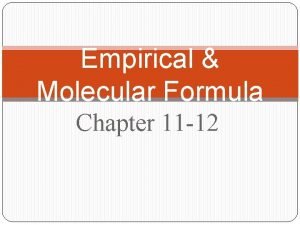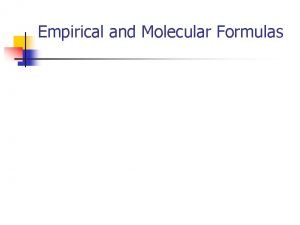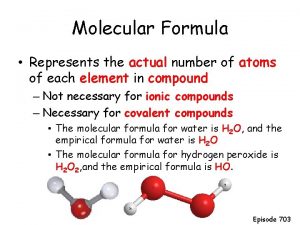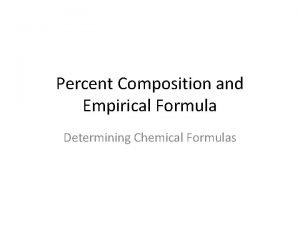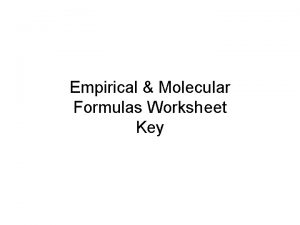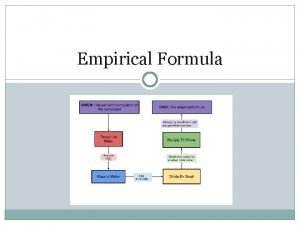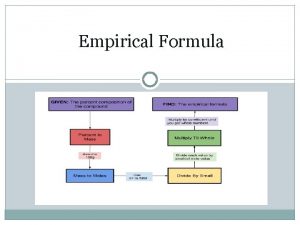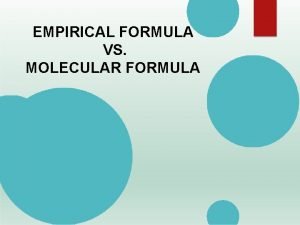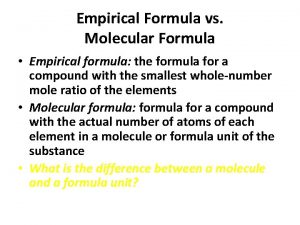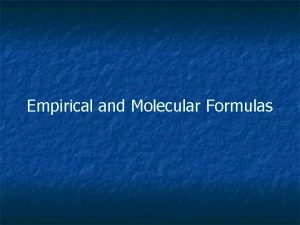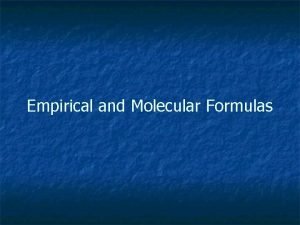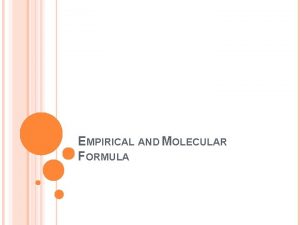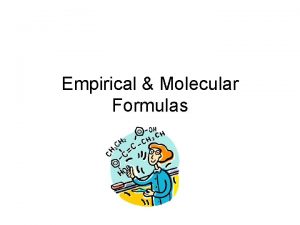Quantitative Chemistry Part 2 Empirical Formula and Molecular











- Slides: 11

Quantitative Chemistry Part 2 Empirical Formula and Molecular Formula

Empirical Formula What is meant by the term ‘empirical’? The term ‘empirical’ means ‘determined by experiment’ What does the empirical formula tell us? The empirical formula tells us the simplest formula of a compound – and just shows the ratio of the numbers of atoms each element in a compound.

Example The chemical formula (molecular formula) for hydrogen peroxide is H 2 O 2 The elements hydrogen and oxygen are present in the ratio, 2: 2 or simply, 1: 1 Hence, the empirical formula for hydrogen peroxide is: HO In other words, chemical analysis of a sample of hydrogen peroxide would show that hydrogen and oxygen atoms were present in the ratio 1: 1

Another example Butane is the gas used as a propellant in some aerosol cans. Its chemical (or molecular formula) is C 4 H 10 The elements carbon and hydrogen are present in the simple ratio, 2: 5 Therefore, the empirical formula for butane is: C 2 H 5

Calculation of Empirical Formula from experimental data. A compound has the following composition by mass. Na = 29. 1%; S = 40. 5%; O = 30. 4% Hence, in a 100 g sample, there would be: 29. 1 g of Na; 40. 5 g of S; and 30. 4 g of O The relative atomic masses of these elements are: Na = 23; S = 32; O = 16.

…calculation continued Atoms of sodium = Mass Ar Atoms of sulphur = Mass Ar Atoms of oxygen = Mass Ar = 29. 1 23 = 1. 265 = 40. 5 32 = 1. 266 = 30. 4 16 = 1. 900 For the empirical formula, the numbers of atoms of each element must be whole numbers (integers!)

…. . continued The ‘trick’ to obtain whole numbers is to: divide each of the previous answers by the smallest! i. e. 1. 265 Atoms of sodium = 1. 265 = 1. 00 Atoms of sulphur = 1. 266 1. 265 = 1. 00 Atoms of oxygen = 1. 900 1. 265 = 1. 50

……. continued If we still do not have whole numbers: Multiply all answers by a suitable small number – i. e. 2, 3 or 4 In this case, multiply all answers by 2, so that the empirical formula becomes: Na 2 S 2 O 3

Molecular Formula The molecular formula for a compound is the formula that shows: the actual numbers of each type of atom in the molecule To calculate the molecular formula of a compound, we need to know its empirical formula and its molecular (formula ) mass.

Example What is the molecular formula of a compound which has the empirical formula, C 1 H 1 and a molecular mass (Mr) of 78? C = 12; H = 1. We start by saying : (C 1 H 1)n = 78 (12 + 1)n = 78 13 n = 78 78 n= =6 13 Hence, the molecular formula is C 6 H 6

• tyui
 Which formula is an empirical formula?
Which formula is an empirical formula? Cho empirical formula
Cho empirical formula Empirical formula
Empirical formula Empirical formula and molecular formula pogil
Empirical formula and molecular formula pogil Empirical formula of pentane
Empirical formula of pentane Mass practice problems
Mass practice problems Empirical formula of haemoglobin
Empirical formula of haemoglobin How to find the empirical formula
How to find the empirical formula Empirical formula of glucose
Empirical formula of glucose Molecular formular
Molecular formular Empirical formula to percent composition
Empirical formula to percent composition Empirical and molecular formula worksheet doc
Empirical and molecular formula worksheet doc

